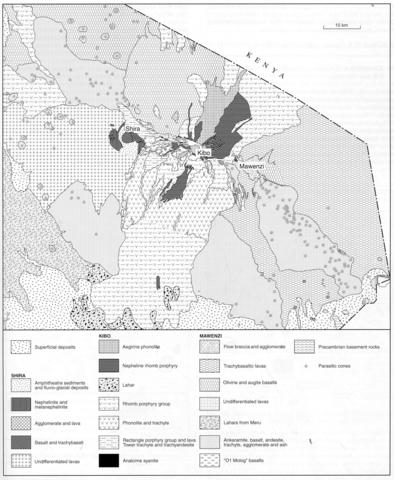stripes
Reaching an elevation of 5895 m the Kibo summit of Kilimanjaro is the highest mountain in Africa and maintains a summit glacier (Osmaston, 1989). The main peaks are in Tanzania but the lower parts of many of the northern and eastern lava flows extend into Kenya (see Kenya No, 72). It forms a shield of about 96x64 km elongated along an east-southeasterly axis, with the three main eruptive centres of Shira, Kibo and Mawenzi along this line; there are numerous much smaller eruptive centres on the flanks. Most of the mountain is covered by eruptive products from the three main centres, which are depicted on the 1:125,000 geological map (Downie and Wilkinson, 1964). The Shira and Mawenzi centres are older than most of Kibo, the products of the last being domed against and overlapping those of the former two centres (Downie and Wilkinson, 1972). The southwestern part of Kilimanjaro is built of various lavas that emanated from the Shira centre and these are bounded on their northern and eastern sides by lavas that emanated from parasitic cones and rhomb porphyry from Kibo, which in turn extend over the 'Ol Molog' group of basaltic lavas that may be part of the Shira group or older. The summit area of Shira comprises what is thought to be a crater that is partly filled by later sediments and lavas, and remnants of a plug of agglomerate with analcime basalt fragments, which has been intruded by dolerite, analcime syenite and essexite. A dyke swarm radiates from the plug. Some 3 km northeast of the plug another and younger intrusive centre is composed of lavas of glassy aegirine nephelinite with biotite xenocrysts and nepheline phenocrysts. The main rock types of Shira include lavas of olivine basalt, trachybasalt, melanephelinite, ankaramite and basanite with considerable pyroclastic material including agglomerates and tuffs. A detailed section nearly 500 m thick in the caldera wall is described by Downie and Wilkinson (1972). On the eastern side of the crater are fluvio-glacial deposits within which are conglomerates containing pebbles of ijolite, nepheline basanite, phonolite and melanephelinite thought to derive from a centre now buried by Kibo lavas. Mawenzi, the most easterly centre, is deeply eroded and partly overlain by the Main Rhomb Porphyry group of Kibo, but may have still been active when the Kibo centre commenced. The principal lavas are olivine basalt and trachybasalt. The main eruptive centre is difficult of access, and so not well known. The main rocks are agglomerates of blocks of trachybasalt with some syenites, and these are cut by several plugs and sheets of syeno-gabbro. A dyke swarm is confined to the summit area and includes an estimated 600-800 dykes, which are principally basalt and trachybasalt. An extensive lahar, now covering nearly 1000 km2, originated from Mawenzi the outcrops, however, all being within southern Kenya. Kibo, the central cone and highest peak of Kilimanjaro, has a summit crater and an inner crater and cone, which are partly covered by permanent ice. Most of the larger flows originated in the summit area and in general became more silica undersaturated with time. Although few pyroclastic rocks, apart from a lahar which extends many kilometres south of the lava flows, are reported by Downie and Wilkinson (1972), there are outcrops of well-indurated, fine-grained southward dipping tuffs at around 4000 m on the southern slopes of Kibo (J.B. Dawson, pers. comm., 1999). The principal rock types include olivine basalt, trachybasalt, trachyandesite, various types of trachyte with phenocrysts including andesine, oligoclase, orthoclase and anorthoclase, and in some varieties small nephelines. A group of phonolites, occurring on the upper slopes and around the crater, contain nepheline and anorthoclase phenocrysts. Nepheline, occasional feldspar and aegirine phenocrysts characterize one group confined to the crater, while a very extensive series of lavas over the northern and southern flanks are aphyric, trachytic in texture and vary chemically from trachyte to phonolite. An intrusion of analcime syenite is exposed in a landslip scar cutting the outer caldera wall and consists of anorthoclase phenocrysts, alkali feldspar, analcime, biotite, apatite, magnetite, calcite and some green pyroxene. Over 250 lesser eruptive centres have been identified on the slopes of Kilimanjaro and the surrounding plains most of which are cinder cones generally 60-100 m high. Their products include a broad range of lava types. One crater on the Kenya border southeast of Kilimanjaro, which is occupied by Lake Chala, was the source of a widely distributed calcareous tuff, and two small hills to the south are composed of the same rock type. Downie and Wilkinson (1972) give a full account of previous work on the structure, volcanology and petrography of Kilimanjaro, as well as tabulating chemical data. A description of the glacial history is that of Osmaston (1989). The geology of the Tanzanian part of Kilimanjaro is covered by a special sheet of the Geological Survey of Tanzania on a scale of 1:125,000 (Downie and Wilkinson, 1964).
DOWNIE, C. and WILKINSON, P. 1964. Kilimanjaro-Moshi. Geological Survey of Tanganyika, Special Sheet, 1:125,000.DOWNIE, C. and WILKINSON, P. 1972. The geology of Kilimanjaro. University of Sheffield and Geological Survey of Tanganyika, Sheffield. 253 pp.EVANS, A.L., FAIRHEAD, J.D. and MITCHELL, J.G. 1971. Potassium-argon ages from the volcanic province of northern Tanzania. Nature, Physical Science, 229: 19-20.OSMASTON, H. 1989. Glaciers, glaciations and equilibrium line altitudes on Kilimanjaro. In W.C. Mahaney (ed). Quaternary and environmental research on East African mountains. 7-30. Balkema, Rotterdam.WILKINSON, P., MITCHELL, J.G., CATTERMOLE, P.J. and DOWNIE, C. 1986. Volcanic chronology of the Meru-Kilimanjaro region, northern Tanzania. Journal of the Geological Society, London, 143: 601-5.WILLIAMS, L.A.J. 1969. Geochemistry and petrogenesis of the Kilimanjaro volcanic rocks of the Amboseli area. Bulletin Volcanologique, 33: 862-88.

